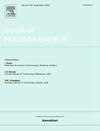Machine learning prediction for thermal–hydraulic parameters of semicircular-fin fuel bundle in lead–bismuth fast reactor
IF 2.3
3区 工程技术
Q1 NUCLEAR SCIENCE & TECHNOLOGY
引用次数: 0
Abstract
In this study, a machine learning approach is used to predict the thermal–hydraulic parameters of lead–bismuth eutectic flow in a new-style semicircular-fin rod bundles. With numerical simulation data, a novel micro segment method was used to extract data from 42 sub-channels and 19 fuel rods in the fluid domain and establish a database with 23,313 data points. Four machine learning models are used to predict the h and ΔP by normalizing the input parameters with model hyperparameter optimization. The results show that all of the four machine learning models have good prediction accuracy, with the error of less than 5% and MAPE were all within 1%. The performance of ANN model is better than that of the other three models in predicting new cases. It indicates that ANN model has a high accuracy in predicting thermal parameters under new cases, which verifies the applicability of the machine learning prediction method for multiple cases. This study confirmed the advantages of machine learning in predicting complex regular parameters, and proposed a new method for flow and heat transfer parameters prediction in the development of a subchannel analysis program for semicircular-fin rod bundles.
铅铋快堆半圆翅片燃料束热水力参数的机器学习预测
本文采用机器学习方法对新型半圆翅片棒束中铅铋共晶流动的热工参数进行了预测。利用数值模拟数据,采用微段方法提取流体域42个子通道和19根燃料棒的数据,建立了包含23,313个数据点的数据库。使用四个机器学习模型通过模型超参数优化对输入参数进行归一化来预测h和ΔP。结果表明,四种机器学习模型均具有较好的预测精度,误差均小于5%,MAPE均在1%以内。人工神经网络模型对新病例的预测效果优于其他三种模型。结果表明,人工神经网络模型在新情况下的热参数预测精度较高,验证了机器学习预测方法在多情况下的适用性。本研究证实了机器学习在预测复杂规则参数方面的优势,并在半圆翅片棒束子通道分析程序的开发中提出了一种预测流动和传热参数的新方法。
本文章由计算机程序翻译,如有差异,请以英文原文为准。
求助全文
约1分钟内获得全文
求助全文
来源期刊

Annals of Nuclear Energy
工程技术-核科学技术
CiteScore
4.30
自引率
21.10%
发文量
632
审稿时长
7.3 months
期刊介绍:
Annals of Nuclear Energy provides an international medium for the communication of original research, ideas and developments in all areas of the field of nuclear energy science and technology. Its scope embraces nuclear fuel reserves, fuel cycles and cost, materials, processing, system and component technology (fission only), design and optimization, direct conversion of nuclear energy sources, environmental control, reactor physics, heat transfer and fluid dynamics, structural analysis, fuel management, future developments, nuclear fuel and safety, nuclear aerosol, neutron physics, computer technology (both software and hardware), risk assessment, radioactive waste disposal and reactor thermal hydraulics. Papers submitted to Annals need to demonstrate a clear link to nuclear power generation/nuclear engineering. Papers which deal with pure nuclear physics, pure health physics, imaging, or attenuation and shielding properties of concretes and various geological materials are not within the scope of the journal. Also, papers that deal with policy or economics are not within the scope of the journal.
 求助内容:
求助内容: 应助结果提醒方式:
应助结果提醒方式:


